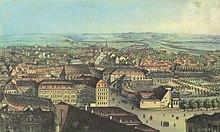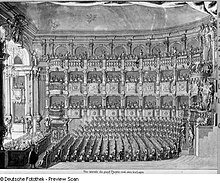Opera house at the Zwinger
The Opera House at the Zwinger was a theater building in Dresden . The three-tier theater, which opened in 1719, held up to 2000 visitors and was one of the largest European theaters of its time. The house experienced its heyday during the reign of the opera-loving Elector Friedrich August II under the direction of Johann Adolph Hasse . The last opera performance took place 50 years after the opening of the house, which was later used as a redoubt and concert hall. It burned down during the Dresden May uprising in 1849 and was then removed.
Inner city location

Matthäus Daniel Pöppelmann , the architect of the Zwinger , was also responsible for the construction of the opera house and placed it directly on the south-western corner pavilion of this baroque structure, which was also under construction at the time. The choice of this location, which is now located on Sophienstrasse , seems unfortunate, because the corner pavilion of the Zwinger, now known as the porcelain pavilion, has its characteristic outlines of the city and disturbed the view from the Zwingerhof over the arched galleries. The art historian Fritz Löffler assumes that the decision for this location was due to the lack of space within the fortress and that Pöppelmann wanted to keep the free space facing the Elbe free for an extension of the Zwinger or a new palace at this point. That room was also vacant at that time and was used both before and later for theaters; today the Semperoper stands there .
While the Zwinger with the corner pavilion delimited the entire north-western side and half of the north-eastern side of the opera house with an arched gallery, the south-western side of the opera house was partially enclosed by the city wall . The rest of the pages faced the street. The Taschenbergpalais and the Sophienkirche were in the immediate vicinity of the opera house .
building
Most of the rectangular area of the 53.58 meter long opera house was taken up by the 23.65 meter wide and 31.35 meter long stage located after the Sophienkirche. Before the 11.40 meter wide opening scene was the orchestra pit . The auditorium began with a gradually rising ground floor, which was followed by rows of steeply arranged seats in a semicircle. Above were three tiers, each with 18 boxes. In addition to these rooms, an extension on the southwest side contained a few salons for the courtyard and dressing rooms for the performing artists. The second floor of the extension housed the cloakroom and equipment room, the third floor housed the opera house supervisor, the theater architect and the theater and inventive tailor. The foyer as well as the entrance to the galaloge were outside the actual opera house; the upper floor of the adjoining kennel pavilion was used for this.
The exterior of the opera house was rather simple and stood in stark contrast to the richly decorated Zwinger. The interior of the opera, on the other hand, was designed by the Venetian theater architects Alessandro and Giramolo Mauro in an extremely splendid way. The ceiling was painted by Giovanni Battista Grone , who also designed theater decorations for performances in the opera house.
history
Since the conversion of the opera house on Taschenberg into a Catholic court orchestra around 1708, Dresden no longer had an opera house. The foundation stone for a new opera house was only laid on September 9, 1718 in preparation for the upcoming wedding celebrations. Just under a year later, construction was completed on August 25, 1719. At the opening on September 3, 1719, the opera Giovi in Argo was given by Antonio Lotti . On September 13, 1719, on the occasion of the celebration of the wedding of the Prince Elector of Saxony, later Elector Friedrich August II, to Maria Josepha of Austria, the opera Teofane was premiered , also by Antonio Lotti based on a libretto by Stefano Pallavicini . Attending festive performances like this one was reserved for court society; in the case of ordinary performances, however, citizens also had access to the rank.
In the early years, Hofkapellmeister Johann David Heinichen and later Giovanni Alberto Ristori worked in the opera house. However, it outshines Johann Adolph Hasse , whose era began with the premiere of his opera Cleofide on September 13, 1731. In 1733 he moved permanently to Dresden and, as Dresden court conductor, formed the opera staff into a top ensemble; his wife, the singer Faustina Bordoni , played an important role as prima donna . In 1738 the opera house was rebuilt under the direction of Andrea Zucchi and expanded in 1749/50 under Giuseppe Galli da Bibiena . The Seven Years' War (1756–1763) meant the temporary end of opera life in Dresden. Hasse's Olimpiade was the last major opera event in 1756. During the unsuccessful siege of Dresden by Prussia under Frederick the Great in July 1760, the opera house suffered severe damage from gunfire; valuable musical notations by Hasse and Heinrich Schütz were also burned . After the war, the opera house was poorly repaired and on August 3, 1763, another Hasse opera could be heard. However, after the death of Friedrich August II on October 5, 1763, the Italian opera was dissolved. They then played in the Morettische Opera House , which had been built shortly before and which served theater purposes up to 1840.
For the wedding of Elector Friedrich August III. with Amalie von Pfalz-Zweibrücken-Birkenfeld-Bischweiler on January 29, 1769, the opera house was used again according to its intended purpose and Johann Gottlieb Naumann's opera La clemenza di Tito was performed. After four repetitions, however, the opera house was closed; from 1782 it was used as a redoubt and concert hall. From 1826 the famous Palm Sunday concerts took place in the opera house. Among others, Felix Mendelssohn Bartholdy conducted his Paulus and Richard Wagner on April 5, 1846 Beethoven's 9th Symphony in 1843 .
During the Dresden May uprising, the rebels saw the opera house as strategically disadvantageous. Because the Prussian troops requested to reinforce the Saxon government seriously threatened the barricade fighters of Dresden, their defensive positions came under increasing pressure. In the course of events, a barricade at the opera house built according to Semper's plans became the focus of the war, which is why the freedom fighters decided to liquidate the opera house. With the approval of the Provisional Government, the barricade commander at the Sophienkirche was commissioned on May 6, 1849 to clear the building and burn it down. Originally it was hoped that the fire would spread to the neighboring Taschenbergpalais. However, the fire spread to the kennel when the wind direction changed. In addition to the opera house, the eastern Zwinger area with the city pavilion was completely destroyed. As early as 1838 to 1841, according to plans by Gottfried Semper, a new Royal Court Theater , the predecessor of the Semperoper , was built immediately north of the Zwinger on today's Theaterplatz .
Web links
Individual evidence
- ^ Fritz Löffler : Der Zwinger in Dresden , chapter: The repetition of the orangery buildings according to the city and the fourth side of the kennel , p. 35. VEB EA Seemann Verlag Leipzig 1976.
- ↑ a b Joachim Näther , Günter Hausswald: Historical foray around the Semperoper, which has been risen in new beauty . In: Bühnentechnische Rundschau, edition 5/1985, p. 22, Friedrich Berlin Verl.-Ges., Berlin 1985.
- ^ A b Heinrich Magirius : The Semperoper Dresden: Building history, equipment, iconography , p. 13. Verlag Edition Leipzig, Leipzig 2004.
- ↑ a b c Matthias Rank: Semperoper Dresden 1985 , p. 10f. Verlag Zeit im Bild, Dresden 1985.
- ^ Hubert Georg Ermisch : The Dresden Zwinger . Dresden 1953, p. 73
Coordinates: 51 ° 3 ′ 7.1 ″ N , 13 ° 44 ′ 2.3 ″ E



